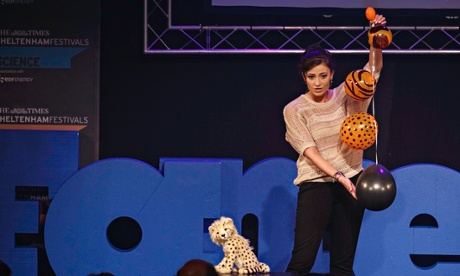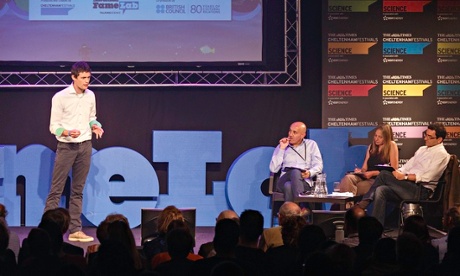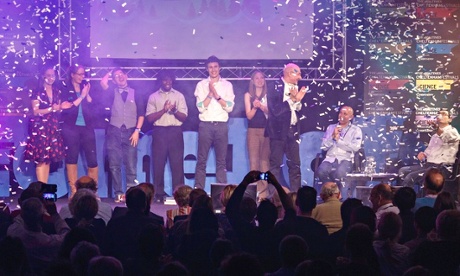Great science communicators can help bridge the gulf between scientists and the public, and the finalists at Famelab International last week showed how it’s done.
It was not exactly Eurovision, but it surely bore many of the same hallmarks: flags from various countries, anxious contestants rehearsing their acts, a presenter checking his script, an empty, floodlit stage as the audience took their seats in the hall. Singing and dancing were not expected (though they are neither forbidden nor discouraged). After all, the contestants were scientists not singers. But they were definitely performers, and they had come to the Cheltenham Science Festival last week to compete in Famelab International for the title of best “stand-up scientist” in the world.
Famelab was founded in the UK by the Cheltenham Science Festival in 2005, but since 2007 it has expanded in partnership with the British Council to 23 countries across every continent, attracting more than 6,000 entrants and reaching millions through traditional and digital media.
The brainchild of science communicators Frank Burnet and Kathy Sykes, Famelab seeks to bring science into the mainstream by subverting the talent competition idea. The young contestants have three minutes to explain a scientific theme in front of a live audience. Props are allowed, providing the contestant can carry them on stage and set them up quickly. Presentations are judged by a jury who ask questions around the theme, and ultimately decide who will bear the coveted title of “Famelab International winner”.

Why go to all this trouble? Why take young talented scientists out of their labs, where they were presumably doing good for the world, coach them like wannabe actors, then hurl them into the lions’ den of public exposure?
Perhaps the answer lies in the famous 1959 “Two Cultures” lecture by C P Snow, in which he lamented the gap between the sciences and the humanities. Snow noted how science was increasingly becoming unintelligible to the wider public, which in a democracy could be troublesome.
Recent years have witnessed a series of bitter culture wars over science, from genetically modified organisms (GMOs) to stem cells, and from climate change to vaccines that purportedly caused autism. In all these wars, points were scored by those who could access the literary arsenal of the humanities and use it to their advantage. Rhetoric often weighed heavier than facts.
Meanwhile, the media oversimplified, sensationalised and polarised. GMOs were called “Frankenstein food”; scientists were depicted as eccentric men on a bad hair day; and human cloning stories were accompanied by a photo of Hitler, like a reflex.
For many in the science camp, letting outsiders frame the scientific agenda and drive public opinion had gone too far. Science had to reclaim its cultural relevance. And that meant that science had to start making sense to the unscientific majority.

Thankfully, since the Two Cultures lecture, much has been achieved to bridge the gap. In the 1980s, Carl Sagan’s TV series Cosmos revealed the beauty of scientific understanding to generations of young people, many of whom were inspired to become scientists too. It was an amazing success, and remains to this day the most widely watched PBS series in the world.
In Britain, too, science is nowadays presented by a new generation of scientists-turned-TV personalities, such as Jim Al-Khalili and Alice Roberts (the two other judges in this year’s Famelab International, with me), and of course Brian Cox. Science is not just for the nerds any more. TV shows such as The Big Bang Theory have tens of millions of viewers. Nerdy and sciencey are the new sexy.
So how do you decide who gets the Famelab prize? From a judge’s point of view this is never easy. There were 10 finalists who performed on the night, young minds who had undergone a gruelling series of heats, semi-finals and science communication training. For most of them it had been a transformative experience. Decoding the mathematical language of science and translating it to an interesting story is far from trivial.

One of the runners-up, David Davila, representing France, explained how language takes shape in the brain by speaking and signing at the same time, making the point that language can take many forms.
The zoologist Joanna Bagniewska from Poland revealed how bees can be trained to detect explosives and illicit drugs, and how they are so many times better at this than sniffer dogs. Other subjects included the mathematics of a leopard’s dots, the evolutionary roots of dancing, and how stem cells could cure dementia.
After much deliberation, we decided to give the top prize to an Irishman representing the tripartite Benelux. By telling us how manipulating photosynthesis could help to feed the billions of people in our world, Padraic Flood showed how a single idea in a person’s head, inspired by the meticulous observation of nature, can make the world a better place. These will always be among the greatest stories ever told.

Original article can be found here.
